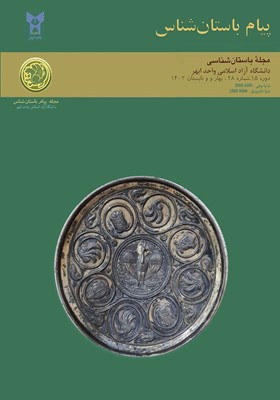کاوشهای باستانشناختی در غار مونه (شهرستان لنده، استان کهگیلویه و بویر احمد)
محورهای موضوعی : باستانسنجی
1 - پژوهشکده باستانشناسی، پژوهشگاه میراث فرهنگی، صنایع دستی و گردشگری، تهران، ایران.
کلید واژه: سفال, غار مونه, لنده, کاوش باستانشناختی, مسسنگی,
چکیده مقاله :
برخی غارها به دلیل شرایط محیطی مناسب برای مدت طولانی کانون استقرار انسان و فعالیتهای انسانی بودهاند و از اینرو، لایههای رسوبی کف غارها و دیوارة صخرهای آنها همواره حاوی مدارک ارزشمندی از تحول جوامع انسانی است. غار مونه از جمله مکانهای باستانی شهرستان لنده در استان کهگیلویه و بویراحمد است که به دلیل داشتن شرایط ویژه، مورد توجه انسانهای گذشته بوده است. بروز اختلافات و درگیری میان اهالی منطقه در پی حفاریهای غیر مجاز آنها در این غار، زمینة کاوش باستانشناختی آن را فراهم آورد. پژوهشهای باستانشناختی صورت گرفته بر روی غار منجر به شناخت سه تالار و یک دالان ارتباطی بین تالارها گردید. علاوه بر این، کاوش دو گمانه در این غار، زمان استفاده از آن را به دورة مسسنگی جدید تا قرون متاخر دوران اسلامی رسانید. طی این دوران، دامداران به طور موقتی از غار استفاده میکردند. بررسی محیط پیرامون غار نیز منجر به شناسایی بقایای دیوارهای سنگچین سترگی در ۲۰۰ متری غرب و شمال غربی غار شد که سنسنجی سفالهای به دست آمده از آن به روش ترمولومینسانس، قدمت آن را به دورة عباسیان رسانید.
Due to suitable environmental conditions, some caves have been the center of human settlement and human activities for a long time. Therefore, the sedimentary layers of the bottom of the caves and their rocky walls always contain valuable evidence of the cultural evolution of human societies. Moneh Cave is one of the ancient places of Landeh County in Kohgiluyeh and Boyer-Ahmad Province, which has been the focus of past humans due to its special conditions. The emergence of disputes and conflicts among the residents of the area due to their unauthorized excavations in this cave provided the ground for its archaeological excavations. The archaeological research on the cave led to the identification of three halls and a communication corridor between the halls. In addition, the exploration of two boreholes in this cave brought the time of its use to the Late Chalcolithic Age until the late centuries of the Islamic era. During this period, the herdsmen of the region temporarily used the cave. The survey of the surroundings of the cave also led to the identification of the remains of large stone walls, 200 meters west and northwest of the cave. The thermoluminescence dating of the pottery of this cave indicates that they belong to the Abbasid period.
افراسیابیان، احمد (1377). اهمیت مطالعات و تحقیقات منابع آب کارست در ایران. در احمد افراسیابیان، مجموعه مقالات دومین همایش جهانی منابع آب در سازندهای کارستی تهران- کرمانشاه، تیر ۱۳۷۷، کرمانشاه: سازمان آب منطقه غرب، 137-126.
شریفی، مهناز (1384). پیچیدگیهای استقراری زاگرس در اواخر پلیستوسن و اوایل هولوسن. اثر، (38 و 39)، 346-۳۵۵.
شرفی، سیامک، مقصودی، مهران (1392). غارها و پناهگاهای صخرهای به عنوان آرشیوی از تغییرات محیطی کوارترنر. در مجموعه مقالات سی و دومین گردهمایی و نخستین کنگرة بین الملی تخصصی علوم زمین، تهران: سازمان زمین شناسی و اکتشافات معدنی کشور، 1 – 5.
عبدی، کامیار (1386). زیست بوم شناسی انسانی و اهمیت آن در پژوهشهای باستان شناختی. باستانشناسی و تاریخ، (31)، 14 – 25.
قربانی، محمد صدیق (1394). چشمانداز کارست به مثابة شاخص استقراری در منطقة کامیاران )گذشته و اکنون(، پژوهشهای جغرافیای طبیعی، 47(۴)، ۵۱۷ -۵۳۱..
کریمی وردنجانی، حسین (1394). هیدروژئولوژی و ژئومورفولوژی کارست. شیراز: انتشارات ارم.
میراسکندری، سیدمحمود (1394). گزارش کاوش باستانشناختی غار مونه (لنده - کهگیلویه و بویراحمد). تهران: مرکز اسناد پژوهشکدة باستانشناسی کشور (منتشر نشده).
Atkinson. T. C. (1993). Present and future direction in karst hydrology. England.
Ashjari, J. Raeisi, E. (2006). Influencees of anticlinal structure on regional flow, Zagros, Iran. Cave and karst science, 68(3), 23 – 44.
Egami, N., & Masuda, S. (1962). Marv-Dasht I: The Excavation at Tal-i-Bakun 1956, Tokyo University Irag-Iran Archaeological Expedition Reports, 2. Tokyo: Institute of Oriental Culture of the University of Tokyo.
Dittmann, R. (1984). Eine Randebene des Zagros in der Fruhzeit: Ergebnisse des Bahbahan-zuhreh Surveys, Berliner Beitrage Zum Vorderen Orient Band 3. Berlin: Dietrich Riemer Verlag.
Heydari, S. (2007). The Impact of Geology and Geomorphology on Cave and Rockshelter Archaeological Site Formation, Preservation, and Distribution in the Zagros Mountains of Iran. Geoarchaeology: An International Journal, 22(6), 653–669.
Mouret C., & Ostermann, J.M. (2001). Human use of caves in Perigord, Dordogne, France. In 13th International Congress of Speleology, 4th Speleological Congress of Latin América, and Caribbean 26th Brazilian Congress of Speleology, Brazilian Society of Speleology, 595-601.
Potts, D. T., Roustaei, K., Weeks, L., & Petrie, C. A. (2009). The Mamasani district and the archaeology of southwestern Iran. In The Mamasani Archaeological Project Stage One: A report on the first two seasons of the ICAR-University of Sydney expedition to the Mamasani District, Fars Province, Iran. Archaeopress.
Renfrew, C., & Bahn, P. (2000). Archaeology: theories, methods and practice. Thames and Hudson.
Samner, W.M. (2003). Early Urban Life in the Land of Anshan: Excavations at Tal-e Malyan in the Highlands of Iran. Museum Monograph, 113, University of Pennsylvania Museum of Archaeology and Anthropology, Pennsylvania.
Wright, H. T. (Ed.), (1981). An Early Town on the Dehluran Plain: Excavations at Tepe Farukhabad, Memoirs of the Museum of Anthropology. Univesity of Michigan, Ann Arbor.
_||_

